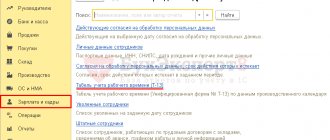Labor intensity by position
In the third section of the calculator, “Labor intensity by position,” it is necessary to list the typical positions of the department (typical - having the same functionality).
For each typical position, it is required to indicate the share of breaks (not including lunch time, since it is not taken into account in the standard working hours) and the share of non-standard operations. These parameters are determined based on the results of photographs of working hours. An example of classifying operations into the categories of normalized, non-standardized and breaks: A large proportion of non-standardized operations in some cases may indicate low efficiency of work organization. Such work can be like constantly “fighting fires” in the confusion of diverse tasks. The best Western practices for managers are no more than 30% of non-standardized operations.
In Section 3 “Labor intensity by position”, the estimated number of employees is also rounded to whole numbers (basically, we do not assume entering partial rates). Rounding is carried out according to the following rule: the number is rounded up if, after rounding, the load on each staff unit does not exceed 115%. That is, the target number of less than 1.15 staff units is rounded to 1, and more than 1.15 is rounded to 2. The target number of less than 2.3 staff units is rounded to 2, and more than 2.3 – to 3. And so on. Based on this principle, any target number above seven staff positions is rounded down.
Topic: Budget and working time fund, classification of worker costs
⇐ PreviousPage 3 of 3Time.
Questions.
1. The concept of working time. Working time budget.
2. Classification of working time costs.
1. Working time is a legally established period of time during which an employee must perform the work assigned to him at the enterprise.
A working day is the length of working time during a day.
Under a five-day work week and normal working conditions, the work hours are 40 hours per week .
Working time includes the period of an employee’s presence at the enterprise from the moment of reporting to work at the hour established by the internal rules until the end of work.
Lunch break time is not included in working hours.
The working time of employees working daily in one shift is taken into account on a daily basis. For continuous production workers working in shifts , monthly is provided (according to the shift work schedule)
There are working hours: regular and extracurricular.
Working time as the length of the working day for workers with daily accounting of working hours and with monthly accounting.
Work time exceeding that established by law is considered overtime.
Working overtime is permitted in cases determined by the Labor Law.
The working time budget is the fund of time spent on production, personal and social needs.
The working time budget is divided into:
- for the time worked at the enterprise;
- for time not used for work for various reasons.
Drawing up a working time budget is necessary both for planning the contingent of workers and for analyzing the use of working time.
Drawing up the annual budget begins with determining the calendar fund of working time Fк, which is calculated by the formula:
Fк = Dr Рср , (hours)
where Dr is the number of working days per year:
Рср – average annual normal working day.
(Dk – Dv – Dp) Рсм – Дс ∆ Рсмн
Рср = —————————————- , where
dr
Rcm – normal shift duration;
Dk - number of calendar days in a year;
Дв, Дп - number of weekends and holidays per year,
Ds - the number of pre-holiday days in a year;
∆ Рсмн — normal shift duration on pre-holiday days.
The calendar fund of working time Fk consists of time worked, time of absence from work due to illness, performance of state and public duties, absenteeism, absence from work for various reasons on average per employee; normal and average working hours.
All employees are granted annual leave with preservation of their place of work (position) and average earnings. The next vacation is granted to the employee on the basis of the vacation schedule once a year and its replacement with monetary compensation is not allowed.
Duration of vacation for railway workers
transport is 28 calendar days.
For employees engaged in work with hazardous working conditions, additional leave is provided in accordance with the legislation. Students of secondary and higher institutions are also provided with additional study leave.
The nominal working time fund Fn represents the legally established duration of work of one payroll employee during the accounting period.
Fн = (Dr – Dot.sr) Рср, where
Dr – number of working days in a year;
Dot.sr – duration of leave for an individual employee;
Day – average annual normal working day.
Dr.sr = Dr – Day, where
Dr – average number of working days of work per employee;
Days – days of absence from work for any reason.
The effective working time fund Fef represents the time an employee spends at the enterprise to perform the functions assigned to him.
Fef = Dr.sr Rsr
Based on the calendar fund of working hours, the average monthly standard of working hours is determined.
2. Classification of working time costs - combining costs into groups according to certain characteristics.
All working time is divided into two groups:
- working hours;
- break time.
Working time can be: productive and unproductive .
Productive time (PT) is the time spent on preparation, direct execution and completion of a production task.
This includes:
-preparatory and final (PZ);
-operative (OP);
- workplace servicing time (Tb). (On) – time spent preparing the workplace and cleaning it after completion.
Unproductive working time (UW) - time spent doing random and unnecessary work.
The time for performing random work (Cr) is the time for performing work not provided for by the production task, but caused by production necessity (correction of defects, tools, elimination of defects).
The time required to perform unnecessary (non-production) work (WW) is the time spent on performing work that does not result in an increase in production or improvement in quality (extra actions due to inexperience).
Break time (P) —
the period during which the performer does not participate.
There are regulated and unregulated breaks:
Regulated breaks (R) - time during which the performer does not work for reasons (rest, industrial exercises, natural needs).
Break for rest and personal needs (Potl)
– time used by the performer for rest in order to maintain normal performance and prevent overwork, as well as breaks for personal hygiene.
Organizational and technical breaks (OT) are breaks established by the technology and organization of the production process (passing trains when working on sections).
Unregulated breaks are time lost due to disruption of the normal flow of the production process (PNT) - breaks in work associated with poor work organization (waiting for transport to go to the line, untimely delivery of material, and violations of labor discipline (LDP) (being late for work, unauthorized absences from work).
When compiling the time limit for an operation, it includes:
T = Top + Tob + Tpz + Totl + Tpt
The remaining components are lost working time.
Observation sheet for a working electric welder
When surfacing crosspieces
⇐ Previous3
Didn't find what you were looking for? Use Google search on the site:
Labor intensity factors
To fill out the fifth section of the calculator, “Labor Intensity Factors,” you need to identify the population drivers. In our example, this is the number of customers and the number of orders. There should not be many drivers, ideally no more than three. Drivers are the primary factors for most of the secondary factors that determine the amount of work. For example, the number of new customers (customer base growth) usually correlates with the total number of customers. Also, the number of customers eligible for a discount may statistically depend on the total number of customers. The dependence of secondary factors on certain drivers can be established by analyzing the company’s statistical data.
Sometimes it is statistically impossible to install a driver for some business processes. In this case, we can use a constant - a fixed amount of work that does not change over a long time. In our case, the constant is the number of price list mailings, since in our fictitious company it is sent out daily on weekdays.
The procedure for filling out the fifth section of the calculator: 1) Determine the secondary factors that determine the amount of work for each process and fill out the second column; 2) Identify population drivers and enter them into the first section of the calculator; 3) Return to the fifth section and select the required drivers from the list, 4) Specify constants for business processes without drivers.
After entering your data, you can return to the first section of the calculator and view the resulting headcount calculation. If you need to modify the calculator, download the Excel file to your computer and make the necessary changes to it.
Methods for calculating staffing levels
At state-owned enterprises, the required number of employees is determined and controlled without fail. Therefore, most calculation methods were developed for public sector companies. Thus, the “Recommendations for determining the staffing level of employees of budgetary organizations based on labor standards” approved by Roszdrav lists methods based on the following standards:
- working time - the working time required by employees to perform a certain job;
- load - the amount of work that an employee or group must complete during working hours;
- service time - workplaces that must be serviced by a specialist during working hours;
- number - the number of employees that one manager can organize.
According to the Recommendations, the maximum staff size of a budgetary institution is calculated using the formula:
| Headcount | = | Total costs for the year (h) | / | Standard working hours for each employee per year (hours) | * | Absence rate due to illness, vacation, etc. |
Recommendations are given for budgetary enterprises, but the standard is also applied by commercial companies.
How to enter data to calculate headcount
Pay attention to the color coding of the cells of the data entry sheets - you need to enter data in the fields without a brown fill.
Open the “Description of Work” sheet, select from the drop-down list the position that performs a specific operation.
If the same work is performed by employees occupying different positions, this means that there are shortcomings in the organization of work, the principle of division of labor is not implemented.
It is possible to replace employees who are absent from work on weekends or the possibility of duplicating their functions in case of employment in other jobs or if it is necessary to simultaneously perform a larger volume of work than usual.
In the next field, indicate the business process/work block.
Then you indicate the operation, its duration (maximum/minimum), select from the drop-down list the appropriate parameter for the frequency of the operation performed, indicate the frequency of the operation itself and the number of workers required to complete it.
This is what it looks like (click to enlarge image)
After you have figured out the amount of work, go to the “Working time” sheet.
Everything on it should be intuitive, special attention should be paid to the red “Losses” column.
It includes the total time of lost working time - time to “switch” from one type of work to another, losses due to ineffective organization of work, due to uneven workload (for example, at first there are no buyers, and then an influx), technological interruptions (need wait until some work is completed, then start others), time to complete urgent and unscheduled tasks, losses due to violations of labor discipline, etc.
How to calculate the number of employees
One of the formulas for calculating staffing levels is based on comparing revenue with working hours:
N = Ov ÷ (Frv × Vpl × Kvn)
where Ov is the planned volume of work or revenue;
Фрв - planned working time fund in hours (with a 40-hour working week, the time fund averages 2004 hours per year, 167 hours per month);
Vpl - planned output per employee;
KVN is the planned rate of fulfillment of the norm.
Example. The sales department consists of 15 people. Management wants to calculate whether the division can be downsized. To determine the staffing level, the personnel officer used the formula N=Ov÷(Frv×Vpl×Kvn).
The planned sales volume indicator for January - June 2020 is 58,000,000 rubles. The working time fund (FWF) for this period is 1,002 hours. The planned output per employee is 755,000 rubles/month. Actual output for January - June 2020 - 644,373 rubles / month. The planned rate of fulfillment of the norm (Kvn) is calculated as the ratio: 755,000 / 557,373 = 1.17. The planned output per hour per employee will be 4,521 rubles/hour (755,000 / 1,002 × 6 months). Substituting the values into the formula, the personnel officer received the result: 58,000,000 / (1,002 × 4,521 × 1.17) = 10.9 - rounded to 11 people. Therefore, at first glance, there is an excess of staff in the sales department.
This formula does not take into account working conditions, the specifics of the enterprise’s activities and the human factor (people are not robots, they get sick, go on vacation, etc.).
Calculation of working time ratio
How to calculate the working time utilization factor? The algorithm should be considered using a practical example.
Example
The working day at Alpha LLC is 8 hours. Of these, a worker, on average, spends 1.5 hours on matters not related to production. 6.5 hours of actually worked time remain. In total, the company employs 100 people. It is necessary to calculate the coefficient per day.
The daily coefficient will be: 650h/800h = 0.8125
Each worker must work 22 days per month, that is, 2200 days for the entire staff. But, on average, workers are absent for 2 days every month for personal reasons not related to weekends or holidays. It is required to determine the monthly coefficient.
The monthly indicator is: 2000d/2200d = 0.909
Based on the above, you can calculate the universal coefficient as a percentage:
0,909*0,8125*100 =73,85625%
This is the percentage of total working time that was spent usefully. Of course, in this example the coefficient is relative, since all workers have the same number of absenteeism and downtime. To make accurate calculations, you need to make individual calculations for each employee.
Determination of staffing taking into account the human factor
The calculation of the number of employees is carried out on the basis of the standard - an ideal situation in which all employees are present at the workplace. The standard value does not take into account that employees go on vacation, get sick, etc. To adjust the calculation, the absenteeism coefficient (Kn) is used, which is determined by accurately recording the attendance and non-appearance of personnel from the working time fund:
Kn = 1 + Dn
where Kn is the planned rate of staff absenteeism;
Day is the share of “non-work” in the working time fund.
Taking this coefficient into account, the formula for calculating the standard value will take the form Shch=N×Kn. This formula allows you to determine the optimal number of employees and not overspend the salary fund.
Example. The HR employee determined that the standard size of the sales department is 10.9 people. To clarify the value, he calculated the absenteeism rate (Kn) for the period January - June 2018. The calculation takes into account 35 non-working days with a 40-hour work week, of which 14 are paid leave, 14 are the norm for sick leave, 7 are without pay according to the Labor Code of the Russian Federation, this amounts to 280 hours. The share of “not working” (Day) is equal to the ratio: 280 (absenteeism) / 1,002 (working time fund). The result is 0.28. Absenteeism rate for January-June 2020: 1+0.28=1.28. The optimal number of employees will be 10.9 × 1.28 = 14 people. Therefore, the sales department can be reduced by 1 employee.
An example of calculating the “availability factor” for an IT system
Task: in the Terms of Reference for a complex IT system there was a point - “calculate the system availability factor.”
Solution: use materials from GOST, request additional data from vendors on equipment elements and use simple mathematics to perform the final calculation. Normative references:
GOST R 27.002-2009 (“Reliability in technology (SSNT). Terms and definitions”)
GOST R 27.003-2011 Reliability in technology (SSNT). Reliability management. Guidance for Specifying Reliability Specifications
GOST 27.002-89 Reliability in technology (SSNT). Basic concepts. Terms and Definitions
According to GOST R 27.002-2009 (“Reliability in technology (SSNT). Terms and definitions”) availability factor
(in the field of reliability in technology)
is the probability that the product at a given time is in working condition, determined in accordance with the design under given operating and maintenance conditions
.
Thus, availability reflects the ability of a system to continuously perform its functions.
In general, for information and computer devices, the availability factor is the probability that the computer system will be in working condition at any (arbitrary) point in time.
The availability factor (K) is determined by the formula:
K = MTBF/(MTBF+MTTR)
,
where: — MTBF (Mean Time Between Failure) — mean time between failures (mean time between failures); — MTTR (Mean Time To Repair) — average time to restore functionality (average time to recovery).
Unlike reliability, the value of which is determined only by the MTBF value, availability also depends on the time required to return the system to an operating state.
So, we have a certain IT system (rackmount servers, blade servers, data storage system).
Fault tolerance at the hardware level of such an IT system allows its services to continue operating in the event of a hardware failure of individual components of the server equipment, data storage system or infrastructure.
Fault tolerance of the functioning of the internal components of the IT system is achieved by using the following technologies:
- redundancy of power supplies for server equipment and data storage systems;
- redundancy of server network adapters;
- redundancy of optical server adapters;
- redundancy of cable connection lines for switching servers and data transmission networks and data storage networks;
- duplication of blade chassis modules: power supplies, control modules, fans, switching modules;
- placement of information on disk data storage systems using fault-tolerant disk groups (RAID).
As a result, all the main components of the IT system equipment - servers, power supplies, disk drives, network adapters, switches - are redundant and hot-swappable.
The IT system equipment is powered from two independent sources. The connection of IT system equipment to external data networks and data storage networks is also duplicated.
All subsystems of the IT system have redundancy, so if any element fails, the IT system equipment as a whole will remain in working order. Moreover, replacing a failed element is possible without stopping the IT system equipment.
The probability (P) of one component failing within one year is: P = 1/MTBF.
Failure of a duplicate component will result in equipment failure only if the duplicate component also fails within the time required to hot-swap the component that failed first. If the guaranteed replacement time for a component is 24 hours (1/365 of a year) (which is consistent with established server hardware maintenance practices), then the probability of such an event within a year is:
Having calculated the probability of failure of all N components of the IT system equipment, we can calculate the probability of failure of the IT system equipment within one year by summing each probability of failure:
Since component failures are usually distributed evenly over time, knowing the probability of IT system equipment failure during the year, you can determine its time between failures: MTBFs = 1/Ps.
The IT system equipment availability factor will be equal to: Kit = MTBFs/(MTBFs+MTTR).
Let's calculate the availability factor of an IT system equipment consisting of 26 components (each component has several elements).
The main problem in the table below is the actual MTBF data for each component. Vendors are very reluctant to provide this data. Often you have to enter into correspondence with representatives of vendors to request the provision and clarification of this data.
In the table below, a calculation was made for an “outdated” IT system, but now it has been operating for almost the fifth year in combat mode without component failure, but the Customer is already planning a migration to new components without waiting for the deadlines from the final calculation data.
(*) – initial data on MTBF are estimates provided for these items of equipment from the manufacturer or their equivalents.
As a result, the calculated data for the equipment of our system:
- probability of system equipment failure within a year: 0.0966;
- System hardware MTBF (years): 10.35 (90666 hours);
- average troubleshooting time (hours): 24;
- system equipment availability factor (%): 99.97;
- Average downtime per year (hours): 2.61 (156 minutes).
Based on the final lines from the table, you can see that we have non-duplicated storage elements and this point greatly affects the calculated data.
If possible, you should duplicate these elements (as a recommendation) or use a different storage system layout. This calculation is, of course, very evaluative. But it can provide a basic understanding of whether the system is optimal or needs additional elements.
In fact, these tables with calculations are entered into the required section of the design documentation and issued to the Customer.
It is interesting to perform such a calculation for a set of network equipment (with a maximum breakdown into elements up to the SFP module and power supplies) and compare the final data with different vendors.
Structure and staff of the organization: relationship
The structure and staff of an organization are comparable concepts. The structural features of the enterprise affect the personnel composition and must be taken into account when calculating the staffing level. To do this, the attitude of management employees to ordinary employees is determined:
- what part of the staff is served by one lawyer, accountant, economist;
- how many production and service departments are there in the enterprise;
- how many subordinates does each department head have?
Since the 1930s, standards developed by the French scientist V. Greikunas have been used in personnel matters. According to these standards, a top-level manager has 3-5 ordinary employees, and an average-level manager has 7-9.
Important! Standards are indicative values that reflect industry averages. Therefore, the optimal staffing level is calculated at each enterprise individually.
Author of the article: Irina Smirnova.
Do you have a small business with employees? Maintain personnel records, easily calculate salaries and submit employee reports via the Internet in the Kontur.Accounting service. The service automates most routine operations, eliminates rush jobs, and saves you time and money. The service also includes accounting and tax accounting, preparation, verification and submission of reports, reconciliations with regulatory authorities, expert consultations, and the legal framework. The first 30 days of use are free for all new users.
Who is included in the regular number of employees?
To answer this question, we first find out what quantitative characteristic is meant. The following types can be used in practice:
- Regulatory. This is a kind of standard. It is based on standards and norms determined on their basis.
- Planned. This is a forecast indicator. It reflects the need for personnel for the future period and is identified based on an analysis of past periods.
- Average pay. This is the result of analyzing the number of employees for the period. It does not take into account contractors and external part-time workers.
- Regular. This is the number of members of the workforce in accordance with the staffing table.
- Factual. This is the number of employees working at the enterprise at a particular moment.
- Appearance room. This is the number of employees at the workplace at the time of analysis (actual minus vacationers, sick people, maternity leave, etc.).
The regular and actual number of employees are indicators that differ by the number of seasonal workers, trainees and any other personnel recruited temporarily for special needs.
How has payroll changed in 2020?
Determination of personnel requirements at an enterprise (firm) is carried out separately by groups of industrial and non-industrial personnel. The initial data for determining the number of employees are: production program; standards for time, production and maintenance; nominal (real) working time budget for the year; measures to reduce labor costs, etc.
Task 2 Calculate the number of main workers on the site. There are 365 days in a year, of which 12 are holidays and 103 are weekends. Planned absenteeism from work amounts to 14% of the nominal time fund. The labor intensity of product A is 1.1 standard hours, product B is 1.2 standard hours. The planned production rate is 112%. The production program for product A is 250 thousand units, product B is 330 thousand units.
Restructuring (staff reduction and regrouping of tasks). The challenge should include an analysis of whether new workloads will actually lead to improved results.
The Recommendations discuss general methodological provisions for the use of regulatory materials on the labor of employees of budgetary organizations, requirements for regulatory materials, legal issues of their establishment and replacement, monitoring the state of the regulatory framework and determining the effectiveness of the implementation of regulatory materials on labor.
The regulatory framework of a budgetary organization must be comprehensive, i.e. consist of different types of norms and standards of different levels of consolidation.
A convincing picture that clearly shows the number of tasks performed by the HR department and their labor intensity.
If you really need an additional employee, then you will have arguments for the director. Or you will understand how to distribute work more rationally in order to do without expanding the staff.
The second most popular question is: does the number of accounting departments affect the company’s revenue? For example, should the number change if revenue increased from 200 thousand rubles. up to two million a day? Let's figure it out. We could previously issue one invoice for 200 thousand rubles, but now we issue the same invoice, but for two million. Should the numbers change? Certainly not.
Thus, if we want to determine the optimal number of accounting departments, we need to take into account not only the list of products that it produces. The volume of operations involved in the manufacture of these products is also important.
After the preparatory work has been done for the formation of the payroll, together with an accountant and economist, proceed to its calculation. Start by creating a headcount plan. To do this, count the number of employees currently working for each department and determine the number of staff units according to the staffing table.
The relevance of developing recommendations for establishing the staffing levels of employees of various job categories on the basis of intersectoral, sectoral and local labor standards is largely explained by the fact that the study of the experience of their application in organizations indicates significant differences in the level of effectiveness of the implementation of regulatory materials.
The calendar fund of workers' time, both as a whole and for individual categories and groups, can be determined in two ways: either by summing the payroll numbers of workers for all calendar days of the period, or by multiplying the average payroll number of workers by the number of calendar days in the same period for which the average was determined list number.
We determine the time costs for each process. We record the time required to obtain the required result of the work.
But if only the second approach is used to plan the company’s budget, it is necessary to spend a lot of time and effort on coordinating all financial issues between the heads of the company’s departments.
The inventory should also include skills that go beyond the current competencies of the managers of each position. In order for the company to develop, it is important to improve its composition, so at this stage it is necessary to assess what competencies the employees still lack. Each organization has its own budgeting rules. They are based on the approved management accounting methodology. Therefore, when drawing up a payroll budget, use exactly the format that is compatible with the format of the organization’s general budget.
A man-hour of worked or unworked time is considered to be one hour of an employee’s stay during a shift at the enterprise, and a man-day is one day of an employee during his stay as part of the company’s personnel.
A distinction is made between the full duration of the working day, that is, taking into account overtime hours worked, and the scheduled duration of the working day (without taking into account overtime hours worked). Overtime is hours worked in excess of the statutory working hours (including hours worked on weekends and holidays, unless rest days are provided for them).
The required number of workers is understood as the number that allows them to effectively and efficiently perform specific work while ensuring conditions of scientifically based work and rest regimes.
The next step is to identify the gap between where the organization wants to be in the future and where it is now. Gap analysis involves determining the number of employees and the skills and abilities required in the future compared to the current situation.
When developing different event scenarios, record all the pros, cons and risks of each of them. This information will be useful for management and the budget committee. When using this method, take into account breaks when working on a computer, meetings, business trips, vacations and illnesses of HR employees.










